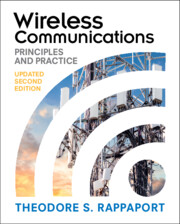Refine search
Actions for selected content:
3527 results in Wireless Communications
8 - Multicarrier Digital Modulation
-
- Book:
- Fundamentals of Digital Communication Systems
- Published online:
- 10 March 2025
- Print publication:
- 23 January 2025, pp 318-344
-
- Chapter
- Export citation
9 - Channel Coding
-
- Book:
- Fundamentals of Digital Communication Systems
- Published online:
- 10 March 2025
- Print publication:
- 23 January 2025, pp 345-391
-
- Chapter
- Export citation
Reviews
-
- Book:
- Fundamentals of Digital Communication Systems
- Published online:
- 10 March 2025
- Print publication:
- 23 January 2025, pp ii-ii
-
- Chapter
- Export citation
Abbreviations
-
- Book:
- Fundamentals of Digital Communication Systems
- Published online:
- 10 March 2025
- Print publication:
- 23 January 2025, pp xix-xx
-
- Chapter
- Export citation
1 - Introduction
-
- Book:
- Fundamentals of Digital Communication Systems
- Published online:
- 10 March 2025
- Print publication:
- 23 January 2025, pp 1-10
-
- Chapter
- Export citation
Notation
-
- Book:
- Fundamentals of Digital Communication Systems
- Published online:
- 10 March 2025
- Print publication:
- 23 January 2025, pp xvi-xviii
-
- Chapter
- Export citation
7 - Spectrum of Digitally Modulated Signals
-
- Book:
- Fundamentals of Digital Communication Systems
- Published online:
- 10 March 2025
- Print publication:
- 23 January 2025, pp 290-317
-
- Chapter
- Export citation
Copyright page
-
- Book:
- Fundamentals of Digital Communication Systems
- Published online:
- 10 March 2025
- Print publication:
- 23 January 2025, pp iv-iv
-
- Chapter
- Export citation
Preface
-
- Book:
- Fundamentals of Digital Communication Systems
- Published online:
- 10 March 2025
- Print publication:
- 23 January 2025, pp xi-xiv
-
- Chapter
- Export citation
Further Reading
-
- Book:
- Fundamentals of Digital Communication Systems
- Published online:
- 10 March 2025
- Print publication:
- 23 January 2025, pp 406-411
-
- Chapter
- Export citation
Dedication
-
- Book:
- Fundamentals of Digital Communication Systems
- Published online:
- 10 March 2025
- Print publication:
- 23 January 2025, pp v-vi
-
- Chapter
- Export citation
6 - Single-Carrier Bandpass Transmission
-
- Book:
- Fundamentals of Digital Communication Systems
- Published online:
- 10 March 2025
- Print publication:
- 23 January 2025, pp 242-289
-
- Chapter
- Export citation
2 - Mathematical Preliminaries
-
- Book:
- Fundamentals of Digital Communication Systems
- Published online:
- 10 March 2025
- Print publication:
- 23 January 2025, pp 11-74
-
- Chapter
- Export citation
10 - Topics in Communication System Design
-
- Book:
- Fundamentals of Digital Communication Systems
- Published online:
- 10 March 2025
- Print publication:
- 23 January 2025, pp 392-405
-
- Chapter
- Export citation
3 - Digital versus Analog Transmission
-
- Book:
- Fundamentals of Digital Communication Systems
- Published online:
- 10 March 2025
- Print publication:
- 23 January 2025, pp 75-137
-
- Chapter
- Export citation

Wireless Communications
- Principles and Practice
-
- Published online:
- 22 March 2024
- Print publication:
- 08 February 2024
-
- Textbook
- Export citation
Chapter 5 - Mobile Radio Propagation: Small-Scale Fading and Multipath
-
- Book:
- Wireless Communications
- Published online:
- 22 March 2024
- Print publication:
- 08 February 2024, pp 177-254
-
- Chapter
- Export citation
Appendices
-
- Book:
- Wireless Communications
- Published online:
- 22 March 2024
- Print publication:
- 08 February 2024, pp 601-692
-
- Chapter
- Export citation
Chapter 8 - Speech Coding
-
- Book:
- Wireless Communications
- Published online:
- 22 March 2024
- Print publication:
- 08 February 2024, pp 415-446
-
- Chapter
- Export citation
Appendix F - 𝑄, erf & erfc Functions
-
- Book:
- Wireless Communications
- Published online:
- 22 March 2024
- Print publication:
- 08 February 2024, pp 645-650
-
- Chapter
- Export citation
